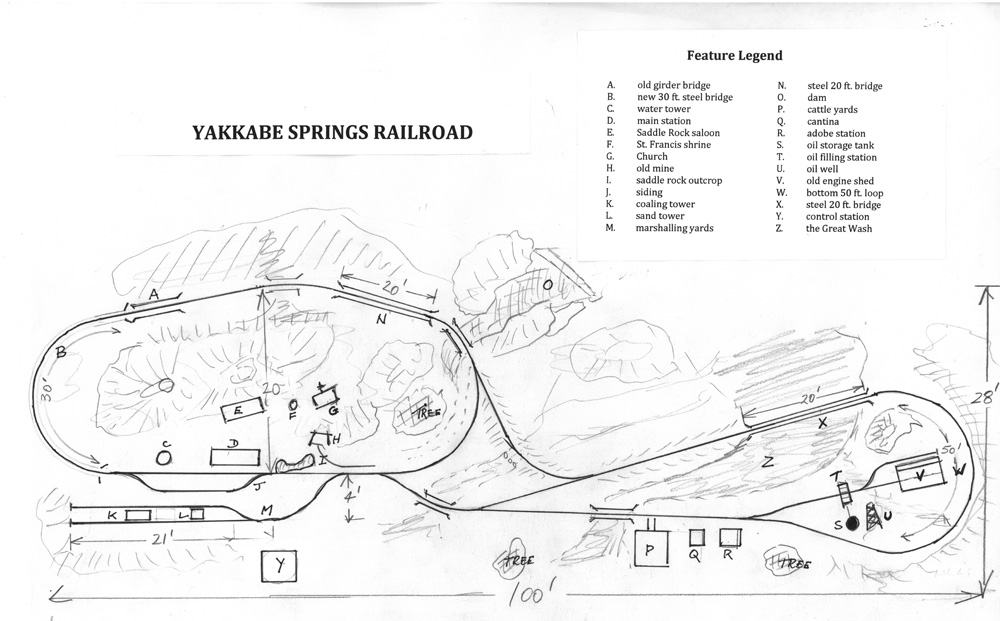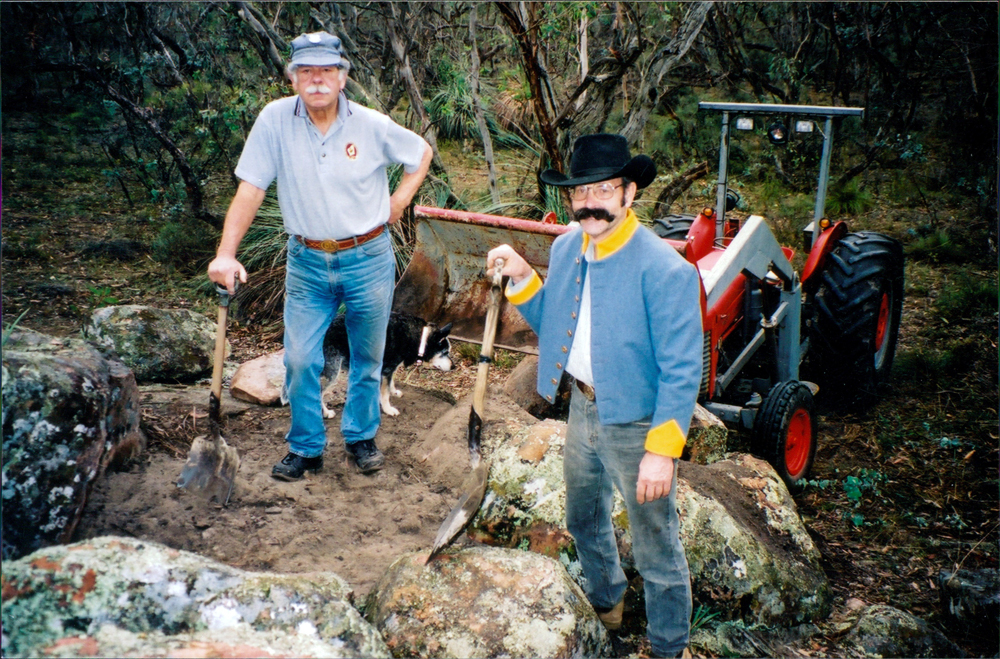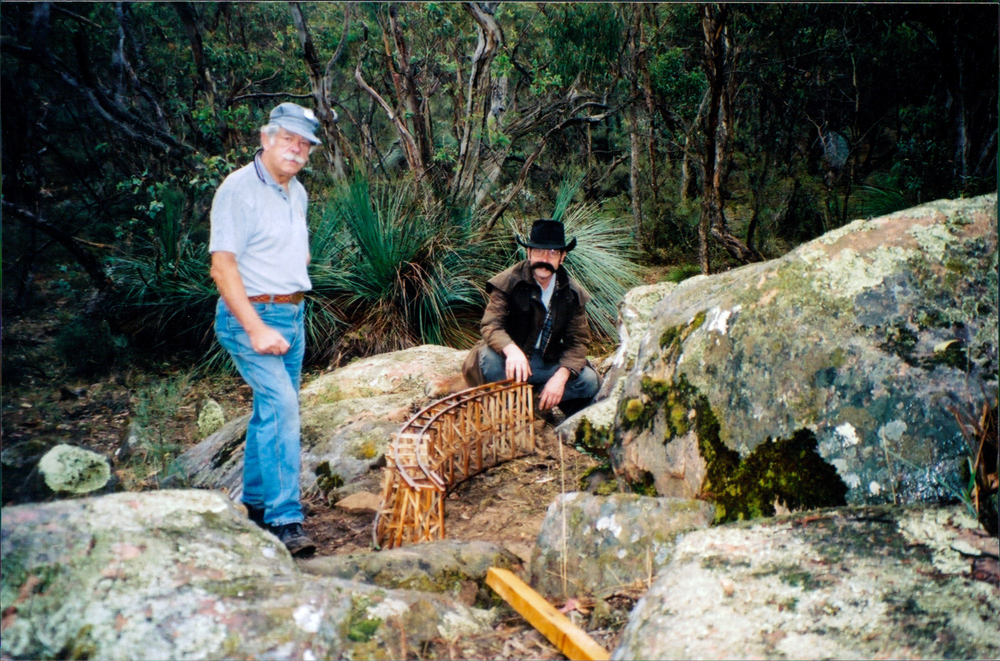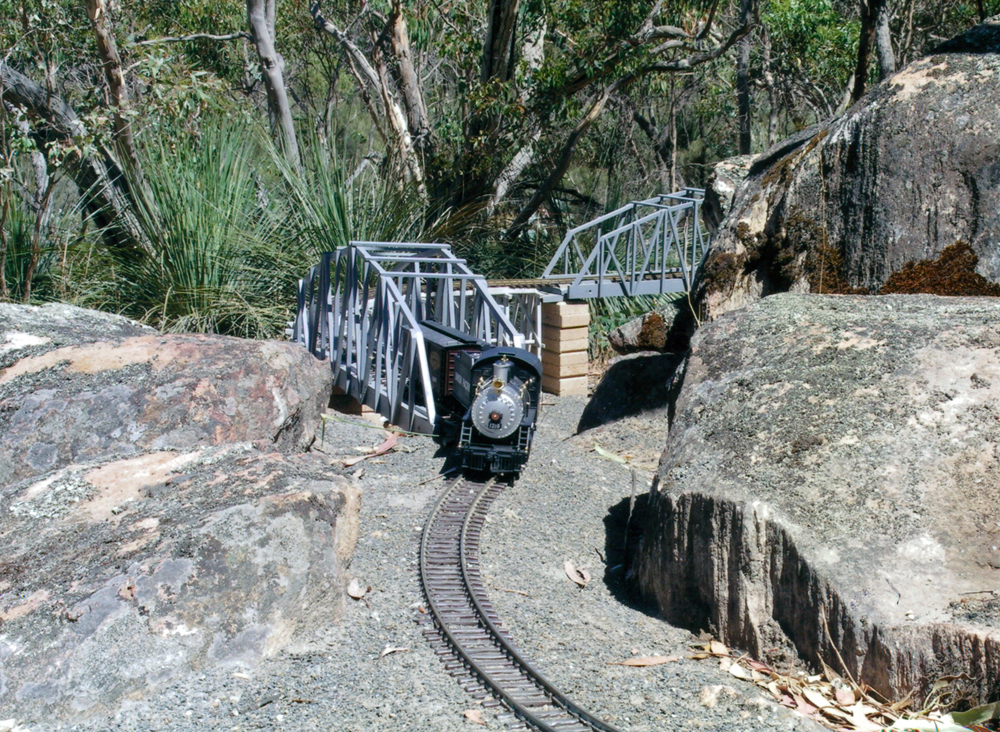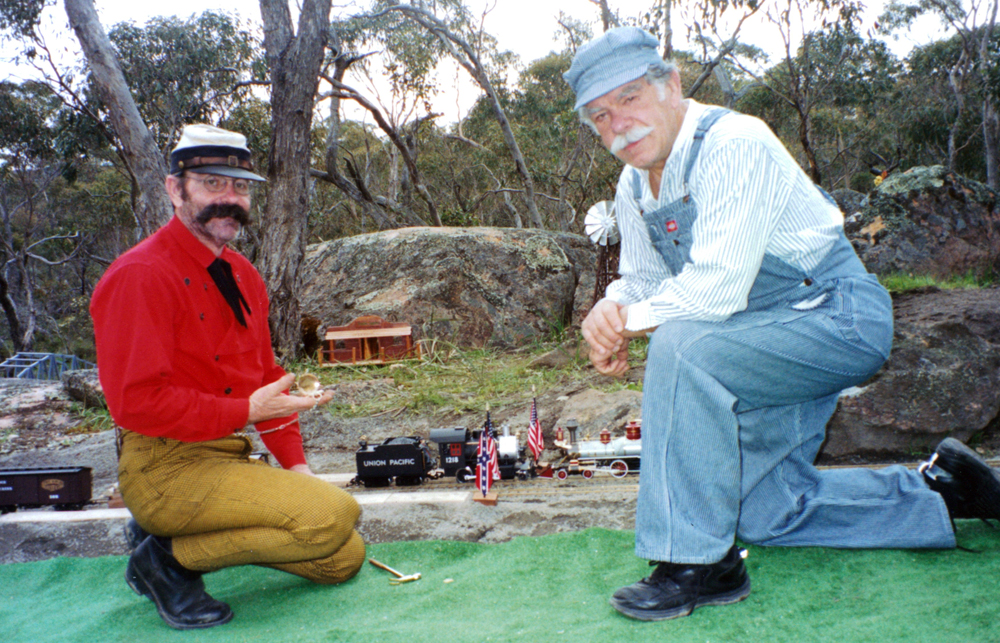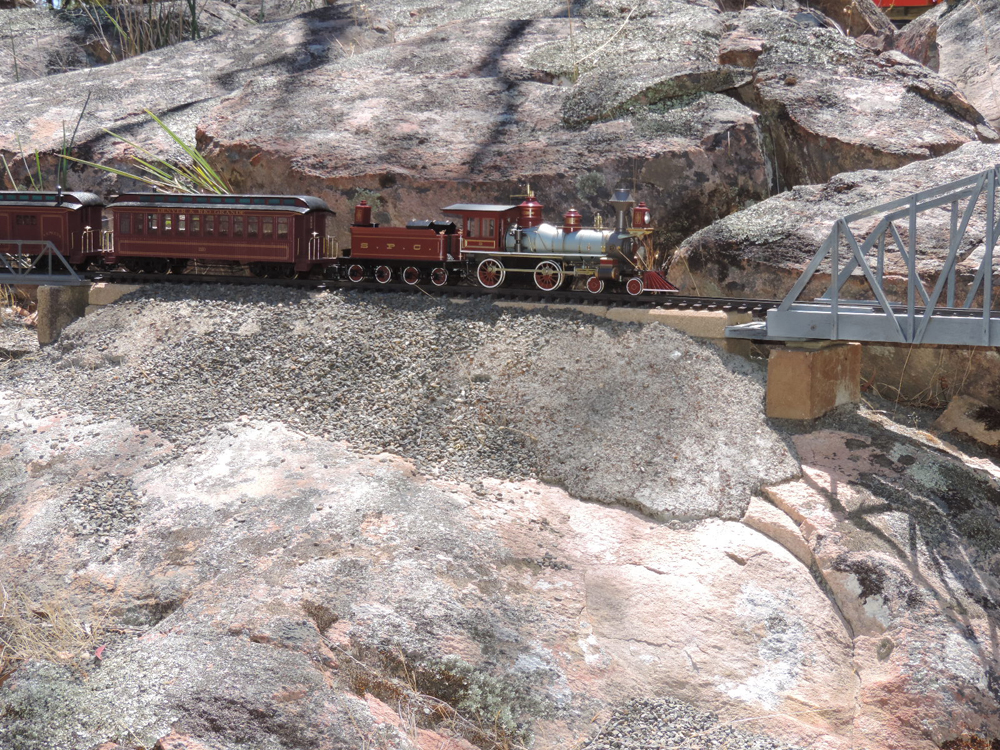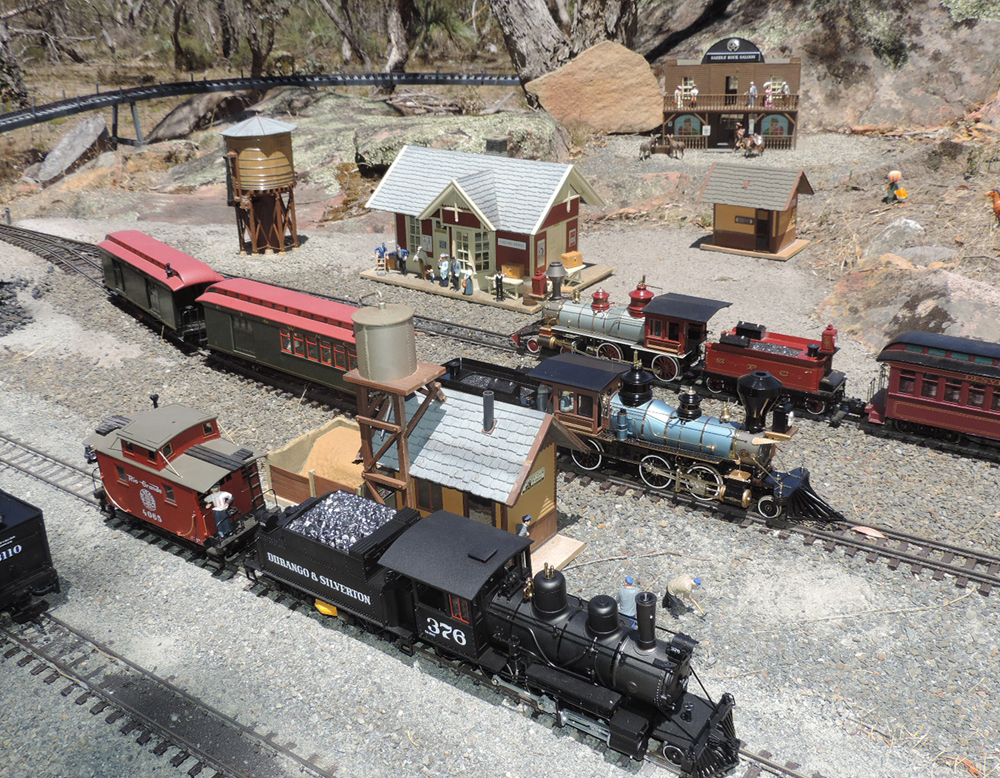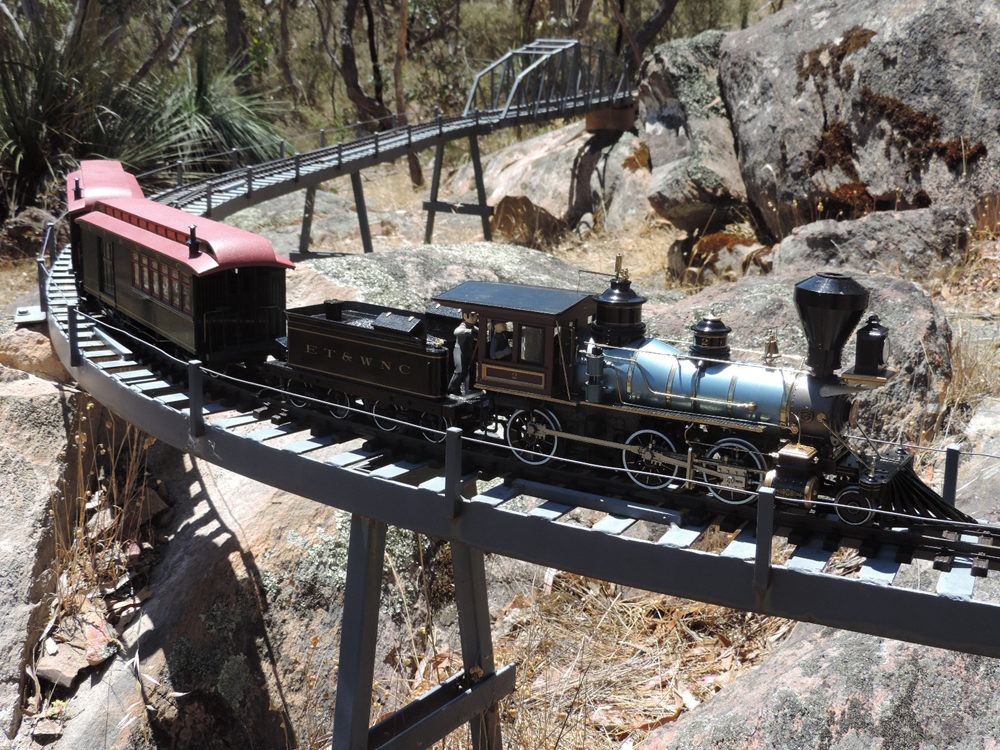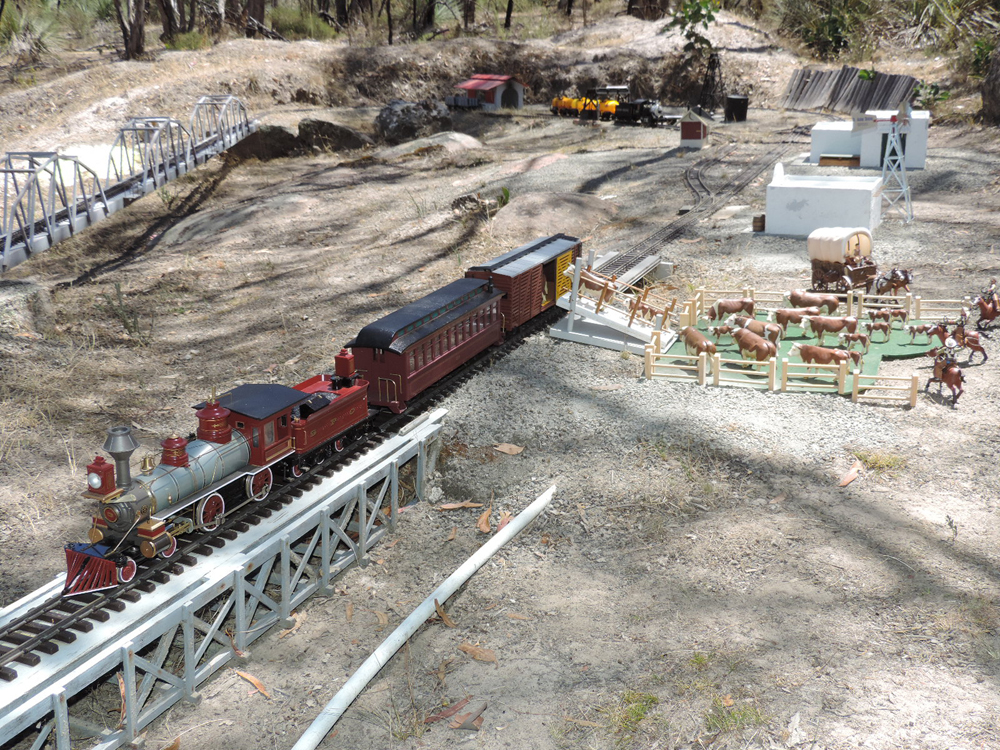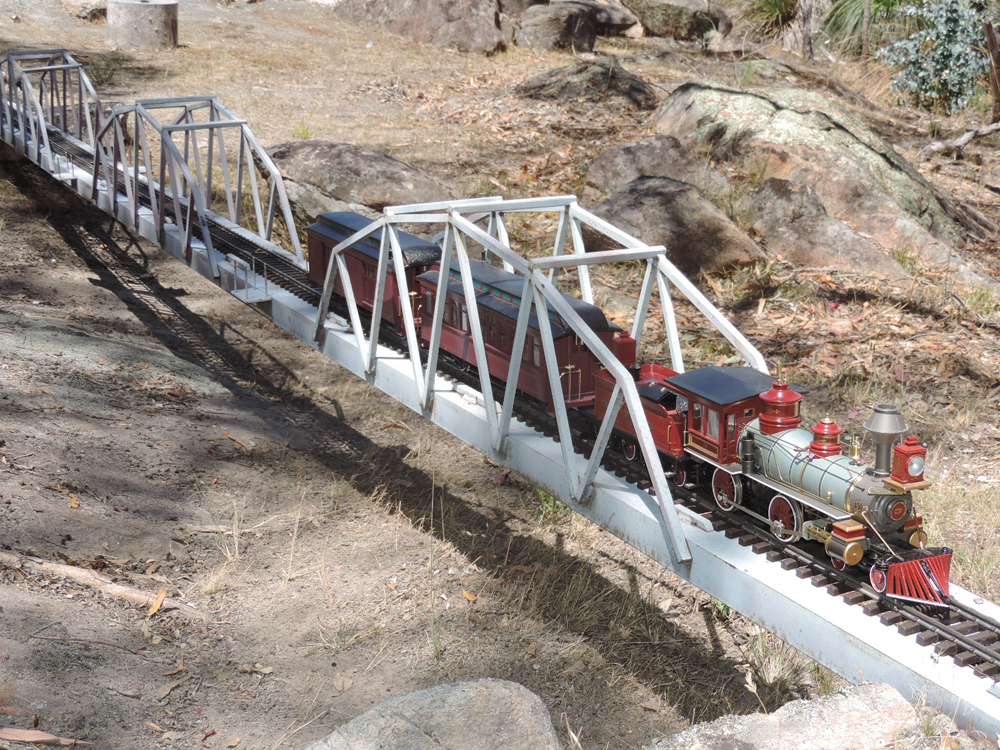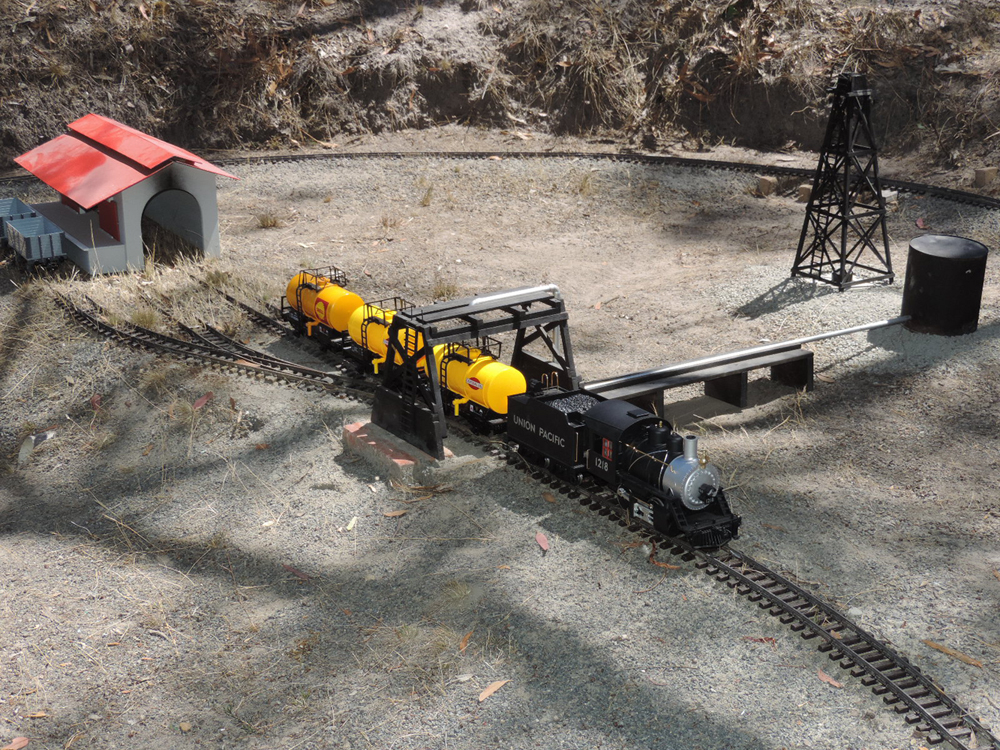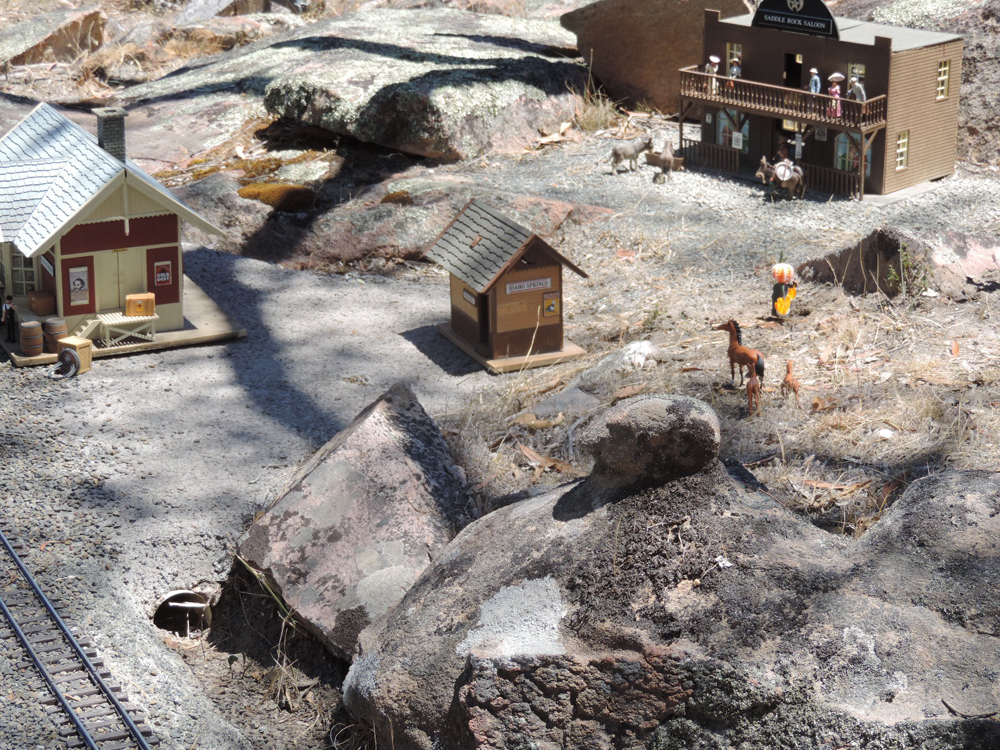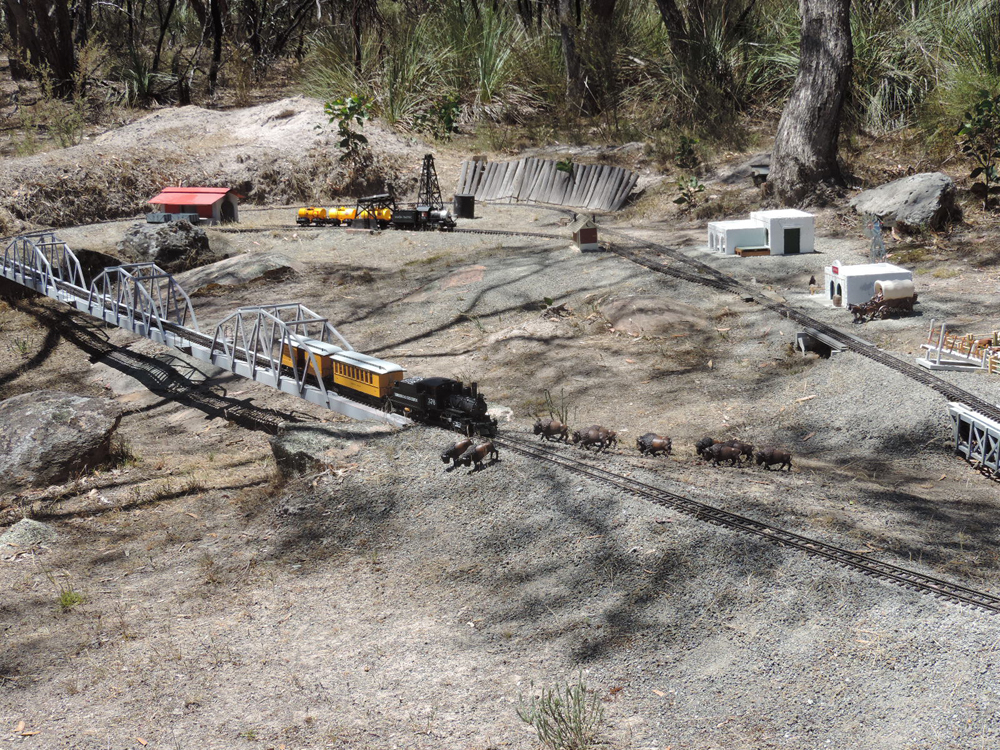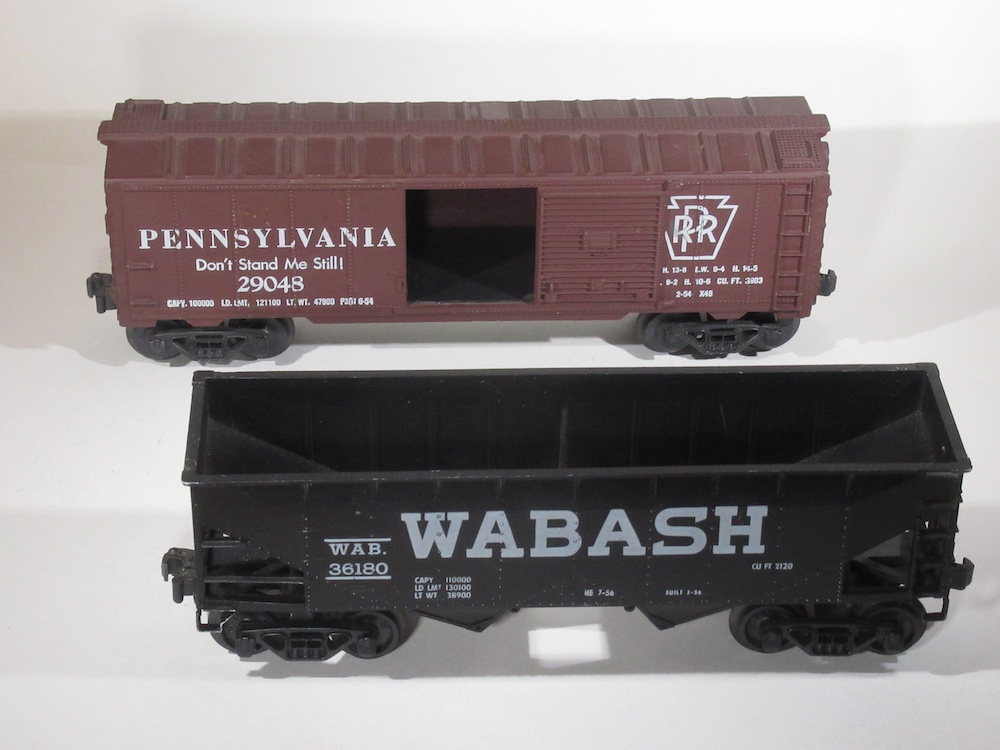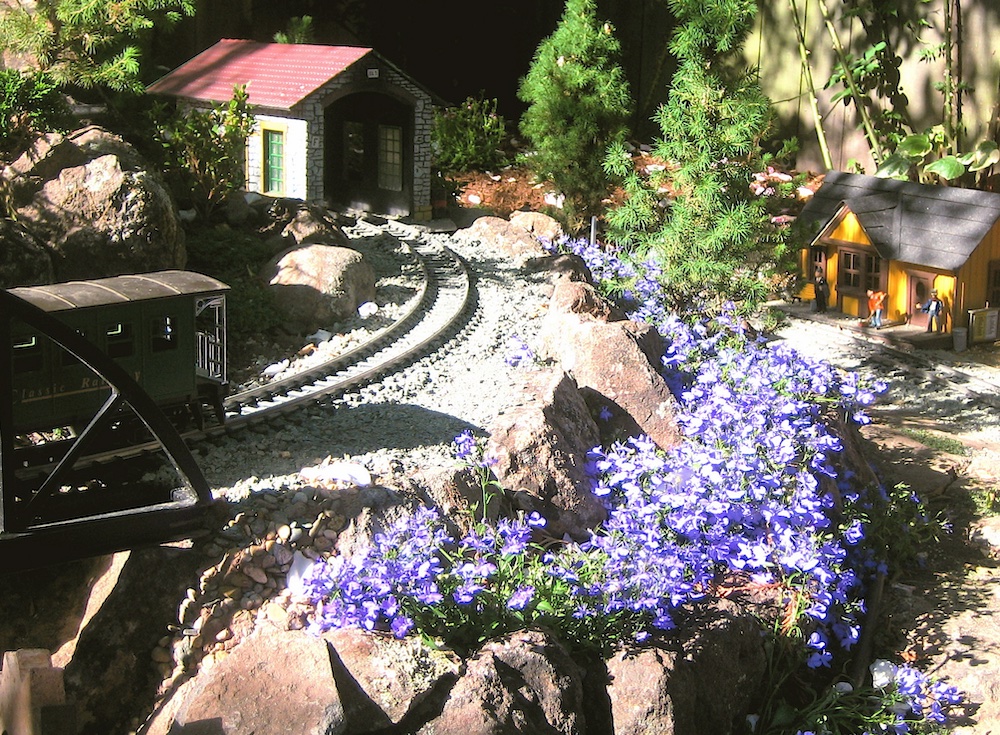Garden railroad in Australia: I have been a model railroader in both N and HO scale, and then I discovered large scale. My other pastime is the sport of Cowboy Action Shooting, so I knew my theme would be the Wild West.
Space was limited on my inner-city block, so I set up a basic double-oval circuit under my pergola with artificial turf and rocks. When I showed my display to Jesse, a fellow cowboy shooter, he was enthralled, but suggested the space was too restrictive and he had just the right place for a railroad on his property outside of town. This acreage would provide an interesting landscape and have more space. After a visit to the proposed site, I was convinced of the need to move.
Starting the build
When constructing a garden railroad, the usual sequence is to determine the track design, construct the scenery (or topography) and, and finally, add the structures. In our case, we would start with the topography and build around it.
By now, Jesse and I had formed a strong partnership and he had the skills, background, and equipment to complete the major groundwork. When searching for a name for our future railroad, we chose to call it “Yakkabe Springs” to reflect the “hard yakka” (slang for hard work) that would be required to build it. Several large rocks had to be moved to clear the way for the tracks along the proposed mountainside section, but the site was used pretty much as nature made it. Later, another cowboy shooter, Mortimer, joined us for the project.
Rights-of-way were graded and the roadbeds were laid with dolomite (crusher dust). In sections where erosion might be a problem, dolomite was mixed with dry cement and watered in.
I brought equipment to the site to start laying the rights-of-way but it soon became obvious that we needed a lot more track to complete the circuit. Bit by bit we invested in track and with my frequent business trips to America, our rolling stock grew accordingly too. My favorite hobby store was St. Aubin Station in Las Vegas, where one walked around a warehouse of goodies and tried not to incur excess baggage fees going home to Australia. [No longer in business. –Ed.]
Garden Railways that gave us hours of enjoyment as we planned the purchase of our rolling stock and locomotives. I acquired a hardbound catalog of LGB trains and their American rolling stock gave us a good selection of period trains. Trainworld provided excellent mail order service. Mortimer contributed a track cleaning locomotive that was invaluable. (This was kept out of sight on operating days!)
The rather dry ground around the chosen site fit in well with the theme of the Wild West, as it provided a sparse landscape. As the years progressed, we added extensions and, as operations moved further into the southwest United States, this dictated the construction of adobe buildings.
A landscape with little or no vegetation provides no impediment to the runoff from heavy rains. However, downpours have been tamed with our network of bridges, arroyos, and storm water pipes to prevent erosion or washaways. Damage to our track has been restricted to falling branches and the kangaroos (nibbling the electric leads to switches and getting their feet caught in the track)!
As our track extended we struck oil! A spur line was built to carry supplies to this enterprise and service the production facilities. Our single wildcat well has produced a great supply of Texas crude. The engineshed that housed mining tools and equipment is now disused; however, a strange, blue engine called Thomas the Tank Engine inhabits the shed and sometimes appears for young visitors.
The Great Wash from the surrounding hills was tamed with a new steel bridge measuring 20 feet. Extended rail yards opposite the main station were needed to cope with the increased freight associated with the oil drilling–and mining–shortlived as it was. Greater freight loads demanded heavier rolling stock and an LGB Mikado locomotive was introduced.
With increased access to the area, tourism became a factor and a modern station was built to provide first class facilities for travellers, complete with a Fred Harvey restaurant. The original saloon was replaced to accommodate tourists and named the Saddle Rock Saloon, after the prominent natural feature close to the railway station.
Settlement brought ranches, of course, and a stock-loading facility had to be built. This led to the construction of an adobe cantina and another adobe station to accommodate the additional passengers. The adobe buildings were from scrap polystyrene sheets covered with cornice plaster and painted with water-based paint. Protruding rafters were made from wooden dowels.
No settlement of the Southwest would be complete without an adobe church for the local population. Our religious roadside shrine to St. Francis is typical of the region.
With the railroad pushing into the Southwest, vestiges of the once vast buffalo herds can sometimes delay the trains. As this area is now a national park, hunting is forbidden.
As the years wore on, termites destroyed the wooden trestles and bridges so we replaced them with steel elevated bridges. Jesse’s engineering skills, a well-equipped workshop, and his tireless attention to detail produced impressive structures. Laying curved track on the ground is easy as one can employ trial and error but when working in steel you have to get it right the first time! As a bonus, this elevated section made it easier to place rolling stock on the track. We have trouble-free running due to a labor of love by Jesse, who soldered every joint in the tracks.
Because the railway was built some distance from the homestead, there was a problem of security and damage to buildings from wild critters. Rolling stock, buildings and figures are put away every time we finished a running session. Initially, this was quite a chore but Jesse found an old blue van that is now a secure mobile storage unit.
Our one drawback is the constant shedding of out-of-scale leaves from the gum trees. They provide great shade for the Australian summers but throw too many shadows for good photography. Unfortunately, Mortimer left the area to live in Queensland but generously donated his track cleaning locomotive.
Nighttime operations
We experienced an unexpected treat during our first night session. The flicker of the fireboxes was quite a sight and the illuminated coaches showed the passengers were enjoying their ride. The locomotives’ headlamps reflecting off the shiny track provided a unique spectacle as one viewed them head-on. One night it was pitch black and calm as I left an operating session early and from quite a distance I heard the distinctive whistle of the Mikado – it was eerie but thrilling.
Future plans
Our most needed additions to the railroad are sound modules in some of the locomotives and novelty sound units such as a honky-tonk piano and revelry coming from the saloon and the lowing of cattle from the stock cars. As a far-away wish, I would like to have a spur line to a winter headquarters for a large circus because, some time ago, I bought some Bachmann Big Hauler circus rolling stock.
Railway at a glance
Name: Yakkabe Springs Railroad
Size of railroad: 100 feet x 28 feet
Scale: Large scale
Gauge: Gauge 1
Era: Southwest USA in Wild West era, about 1870 – 1900
Theme: Frontier development
Age: Ground broken, May 2003/Golden spike, October 4, 2003
Motive power: LGB and Bachmann
Length of mainline: 260 ft.
Maximum gradient: 2.5%
Type of track: LGB
Minimum radius: 5.5 ft
Structures: Mainly hand-built structures plus Pola buildings. Figures and animal selected from Preiser and the Schleich American Frontier selection.Unfortunately, most are now discontinued.
Control system: Direct to track





